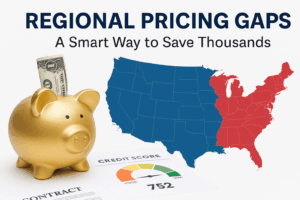Car buyers often assume that incentives are uniform across dealerships. The truth is far more complex. Incentives are shaped by geography, climate, regional demand, and the calendar. A buyer in one city may see a completely different offer than someone shopping for the same model in another region. Understanding how these patterns work is the key to negotiating from strength and avoiding inflated costs.
Why Location Shapes Incentives
Dealers operate within regional markets that have their own demand cycles. A pickup truck in Texas will not be priced the same way as the identical model in New York City. Climate, road conditions, and consumer preferences all influence how aggressively a dealer is willing to discount or bundle incentives.
In colder regions, all-wheel-drive vehicles and SUVs hold value longer, which means dealers have less motivation to offer deep discounts. In warmer climates, convertibles and sports cars command higher prices during peak seasons. The same vehicle can carry a premium in one region and a discount in another, simply because of local demand.
Regional Competition and Inventory Pressure
Competition also plays a role. A dealership in a dense urban area may face pressure from multiple competitors within a few miles. That pressure often translates into more aggressive incentives, especially when inventory is high. In rural areas with fewer dealerships, the same model may be priced higher because buyers have fewer alternatives.
Inventory cycles amplify this effect. If a dealer has too many units of a specific trim, they will push incentives harder to move them. A buyer who understands this dynamic can use regional competition to their advantage by comparing offers across nearby markets.
How Model Year Shifts Create Buyer Leverage
One of the most predictable depreciation triggers is the model year transition. When a new model is released, the previous year’s inventory loses value quickly. Dealers respond by offering incentives to clear out older stock. These incentives can include cashback, low-interest financing, or bundled service packages.
The timing of your purchase relative to a model year shift can significantly affect your total cost. Buying just before the new model arrives allows you to negotiate discounts while avoiding the steepest depreciation. Waiting until after the new model is released may mean deeper discounts but also faster value loss.
Seasonal Shifts in Incentives
Seasonality is one of the most predictable drivers of dealer incentives. Convertibles and sports cars peak in spring and summer, while SUVs and trucks gain traction in fall and winter. Dealers know this and adjust their offers accordingly. Buying a convertible in December or an SUV in July often means better leverage.
Seasonal incentives are also tied to manufacturer campaigns. Automakers often align promotions with holidays or seasonal buying trends. Memorial Day, Labor Day, and year-end clearance events are not just marketing gimmicks. They are structured opportunities where dealers receive additional support from manufacturers to move inventory.
Quarterly and Annual Sales Targets
Dealers do not just operate on seasonal cycles. They also operate on financial calendars. Sales managers are under pressure to meet monthly, quarterly, and annual targets. This pressure often translates into more aggressive incentives as deadlines approach.
Quarter-end discounts are a prime example. In the final weeks of March, June, September, and December, dealers push harder to close deals. They may accept slimmer margins to hit volume bonuses or qualify for manufacturer rewards. Buyers who time their purchase around these cycles often secure better terms than those who shop mid-quarter.
How Buyers Can Leverage These Patterns
The smartest buyers treat incentives as signals rather than surprises. They track regional pricing, monitor seasonal demand, and align their purchase with dealer pressure points. This approach transforms timing into a negotiation tool.
For example, a buyer in a northern state might target SUVs in late spring, when demand is lower and dealers are shifting focus to summer vehicles. A buyer in a southern state might target convertibles in winter, when demand is weaker. Both buyers are using seasonal misalignment to their advantage.
Similarly, comparing offers across regions can reveal hidden opportunities. A truck that is in high demand in one state may be overstocked in another. By expanding your search radius, you can uncover incentives that local dealers are not offering.
Dealer incentives are not arbitrary. They are shaped by geography, competition, seasonality, and financial calendars. By understanding these patterns, you can align your purchase with the moments when dealers are most motivated to negotiate.
Whether you are buying new, used, or certified pre-owned, the key is to treat incentives as part of the larger system. Location and season matter. Inventory cycles matter. Sales targets matter. If you approach the process with this awareness, you will not just save money. You will buy with clarity, timing, and leverage that most shoppers never realize they have.




